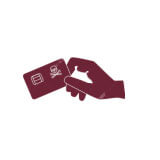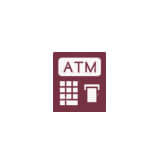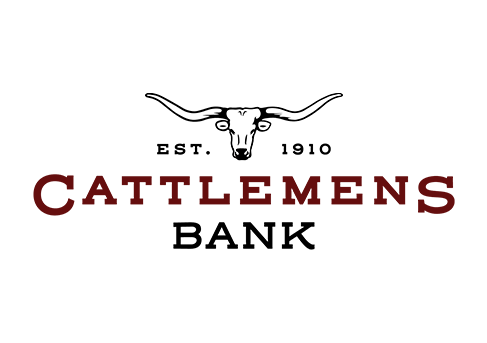Tools you Need to
Protect your Finances

MULTIFACTOR
AUTHENTICATION
Access to Online Banking and Mobile App are secured using multifactor authentication methods to help safeguard consumers from unauthorized electronic transactions, including payments made through Bill Pay.

PERSONAL
VERIFICATION
Online Banking customers are asked to provide 3 Personal Verification Questions in the event of a lost or forgotten password. These questions are unique to you and are not accessible to anyone else.

ENCRYPTED
COMMUNICATION
Your transactions and personal data are protected by encryption software that converts sensitive information into secured code. Whether you login from your computer or phone, your device is registered and recognized for future use.
Security Tips
-Security begins with a strong password, which should include a combination of letters, numbers and special characters that only you possess for increased protection
-Check your account frequently to make sure that nothing out of the ordinary has occurred. Non-consumer accounts are not protected by Reg. E* and should be watched with special consideration.
-Alert the Bank immediately if you suspect or see any fraudulent activity on your account so proper documentation can be completed to begin an investigation into the transaction(s).
-Periodically contact the major credit reporting companies to review your files and make certain the information is correct. For a small fee, you can obtain a copy of your credit report at any time. The three major credit bureaus are-
Equifax – 1 (800) 685-1111
Experian – 1 (800) 682-7654
TransUnion – 1 (800) 916-8800
-Cattlemens Bank will never make an unsolicited request for your Online Banking credentials. Be cautious responding to any email asking for your personal information appearing to come from the Bank and do not click on any link(s) within the email before contacting the Bank to verify its authenticity. Go directly to your Online Banking via our website, cattlemensbank.com to securely login and review your information and account activity.
Phishing
What is ‘phishing”?
It is a form of social engineering, where attackers deceive people into either revealing sensitive information or as the most common type of cybercrime; deceive people into installing malware such as ransomware.
An Email phishing attack involves fraudulent emails or messages that appear to be from a trusted source, such as a bank or government agency. These messages typically redirect to a fake login page where the user is prompted to enter their login credentials.
Spear phishing is a targeted phishing attack that uses personalized emails to trick a specific individual or organization into believing they are legitimate. Spear phishing commonly targets both the elderly and younger age groups who are less aware of cybercrime threats.
Whaling and CEO Whaling attacks use spear phishing techniques to target senior executives and or high-profile individuals with email content appearing to be of a sensitive matter and needing quick resolution. These fake emails trick receivers into acting quickly to protect themselves, their customers or their employees and can result in losing large sums of money.
Clone phishing is a type of attack where a legitimate email with an attachment or link is copied and modified to contain malicious content. It often relies on the recipient trusting an unexpected email with a merchant name or logo they know and react to the email’s positive or negative content.
Voice phishing is where attackers make automated phone calls to large numbers of people, often using text-to-speech synthesizers, claiming fraudulent activity on their accounts. The attackers spoof the calling phone number to appear as if it is coming from a legitimate merchant or business. The victim is then prompted to enter sensitive information or connected to a live person who uses social engineering tactics to obtain information.
SMS phishing or smishing is a type of phishing attack that uses text messages from a cell phone or smartphone to deliver a bait message. The victim is usually asked to click a link, call a phone number, or contact an email address provided by the attacker. They may then be asked to provide private information, such as login credentials for other websites.
Page hijacking involves redirecting users to malicious websites or exploit kits through the compromise of legitimate web pages, often using cross site scripting.
Calendar phishing involves sending fake calendar invitations with phishing links. These invitations often mimic common event requests and can easily be added to calendars automatically. To protect against this form of fraud change calendar settings to not automatically add new invitations.
Cyber Attacks
How Can I Help Protect Myself or My Business From Cyber-Attacks?
Secure your networks and databases by using strong passwords that are complex and changed frequently. Using firewalls can help prevent unauthorized access to your network. Also encrypting your important data can help prevent hackers from accessing your information.
All it takes is one click and you can fall victim to a phishing email or accidentally download malware. Educating yourselves on best practices for cybersecurity is essential for knowing how to identify suspicious emails and links, how to create strong passwords, and how to recognize and report cyber threats.
By establishing rules for password creation, access controls, and data sharing you help to prevent unauthorized access to your data. It is also important to develop a data protection plan in case of a data breach. It never hurts to know what procedures and professional services are available once a breech or identity theft has occurred to assist in containing the damage.
Email filtering involves setting up filters to block spam and other potentially malicious emails. Additionally, filtering out emails with suspicious attachments or links can help prevent malware from infecting your network.
Web filtering involves blocking access to websites that are known to contain malware, phishing sites, and other potentially harmful websites. By blocking access to these sites, you can reduce the risk of a cyber-attack.
Operating system (OS) and Applications security patches are important for keeping your network secure. Software vendors regularly release updates and patches to address known security vulnerabilities. These patches should be installed as soon as they become available to help prevent cyber-attacks that exploit these vulnerabilities.
Anti-virus and anti-malware software are important tools for protecting your network from cyber threats. Regularly updating your anti-virus and anti-malware software is critical to ensuring that your network is protected against the latest threats
If you believe there is any suspicious activity on your account
*Regulation E does not protect non-consumer accounts such as Trusts, Partnerships, Limited Liability Corporations nor any other entity-based structure. Non-consumers should take extra precautions in monitoring all accounts closely and report any potential security breach to assist in offsetting additional risks.*






